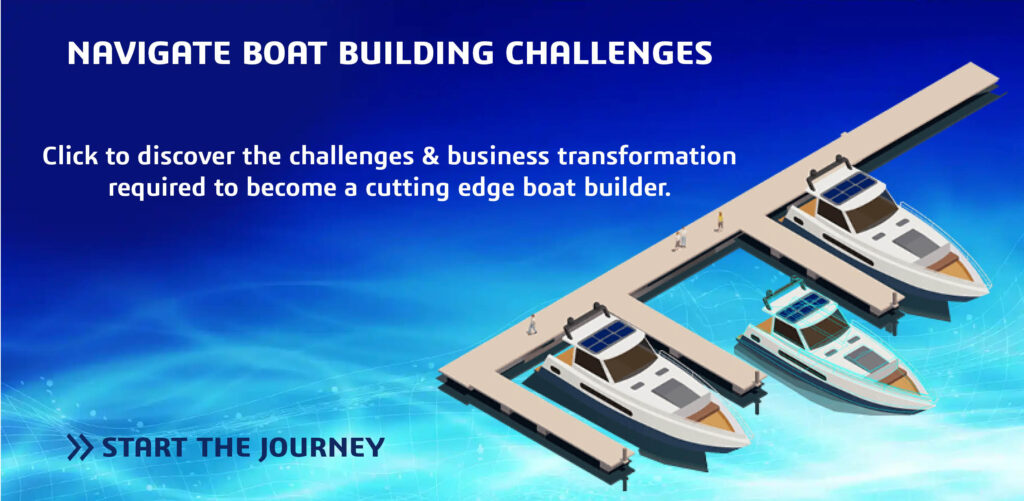If you’ve ever heard of the phrase “A day late and a dollar short,” then you’ll know that it doesn’t often pay to be tardy. Experts such as maritime advisor Lloyd’s Register share this sentiment when it comes to digitalizing boat and yacht building, explaining that as the product development process becomes more complicated and time consuming, boat builders must catch up with other industries such as automotive and harness data in new ways to facilitate better decision-making and solve complex problems. One way of doing this is by using virtual twin experiences to build and test boat designs in the virtual world.
A virtual twin basically means having two identical versions of a boat: the real vessel in the physical world, and an exact replica that exists in a digital environment such as the 3DEXPERIENCE platform on cloud. Boat builders that use the virtual twin find it instrumental for successfully coordinating everyone involved in the product development process. They can virtually design, test and verify every element, complete with all system behaviors, helping them to refine their designs, improve multidisciplinary collaboration and effectively manage a boat throughout its entire lifecycle.
How virtual twins transform leisure boat development
By using virtual twin experiences, boat builders can streamline their product development process. Bringing together designers, engineers and manufacturers on a common platform makes it easier for everyone to work together, leading to better systems integration and the ability to reuse designs and functionalities across projects. It also supports faster iterations and reduces the risk of errors or costly rework during the manufacturing phase.
“The virtual twin allows all relevant stakeholders to access the current model in real time and act on the part or the system that interests them,” said Thomas Normand, CEO of MerConcept, a racing boat builder based in France. “Different teams can ‘speak the same language’ and know that what they’re working on is directly linked to what is actually going on in the workshop.”
At every stage of the development lifecycle, the virtual twin serves as a digital record of what’s happening to the vessel in the real world. This level of visibility and control could transform the entire boat building experience and help to:
- Accelerate product development: Through the virtual twin, designers can create and optimize boat designs, engineers can simulate and analyze performance, and manufacturers can plan and optimize production processes. The virtual twin allows a smoother information exchange between all the stakeholders and reduces manual data transfer errors. It also provides real-time visibility through the boat’s development and production status, so that teams are always informed and can take corrective actions when necessary.
- Improve collaboration: Via the virtual twin, boat builders can pull together all internal disciplines, partners, contractors and customers, allowing them to access and work within the same up-to-date and accurate 3D model, while maintaining IP protection.
- Enhance the customer experience: Thevirtual twin provides an opportunity to showcase boats, including their interior, within immersive virtual reality environments for an effective and engaging sales experience. Potential customers can virtually explore the boat, customize features, interact with different models and visualize exactly how everything will look and function.
- Develop more sustainable processes and products: By digitally testing different materials and configurations in the virtual twin, boat builders can make informed decisions about the most sustainable options, resulting in more fuel-efficient and environmentally friendly vessels. They can reduce waste and lower the environmental impact of their manufacturing processes, while improving the overall sustainability of leisure boats across their lifecycle.

Using virtual twins to customize and market leisure boats
As the pressure intensifies for yacht and leisure boat builders to develop more innovative, customized and sustainable vessels to keep up with consumer and regulatory requirements, they can use virtual twins to tackle complexity and be first to market with the latest advances in boat technology.
Cloud-based solutions like Sea Boat Builder on the 3DEXPERIENCE platform provide all the capabilities boat builders need to handle their entire product development process. Within the virtual twin, they can efficiently accommodate different customization options – whether it’s installing solar panels, offering different propulsion options or integrating self-driving and auto-docking features.
At the same time, they have an opportunity to elevate the marketing and sales experience to appeal to a new generation of customers that are used to shopping online and expect a personalized, digital-led purchasing journey.
“Younger consumers entering the market for recreational boats are digitally savvy,” said a McKinsey report. “They are focused on the experiential aspects behind the lifecycle of buying, owning, or repurchasing a boat.”
This could involve delivering interactive virtual reality experiences where potential customers can explore every detail of the boat within a virtual showroom. Or it could be sharing realistic imagery and videos online so they can see exactly how different customization options will look before they commit to buying.

Is your boat building business ready to embrace the virtual twin?
Today, leisure boat and yacht builders must tackle challenges from all fronts to stay competitive. To stand the best chance of keeping up with the latest industry trends, coordinating a vast ecosystem of internal and external stakeholders, and delivering more customization and sustainability options – all while remaining profitable – they must pursue digital transformation.
To get started, it makes sense to adopt a digital platform like the 3DEXPERIENCE platform on cloud, which seamlessly supports end-to-end product development processes. From there, companies can identify their specific challenges and pinpoint exactly where virtual twins can help them, gradually expanding usage across different projects before fully transitioning to digital workflows.
Discover more on Dassault Systèmes solutions for boat builders
